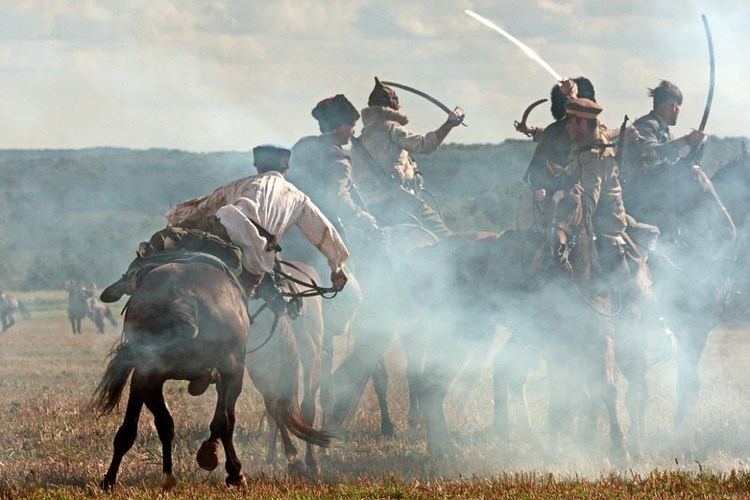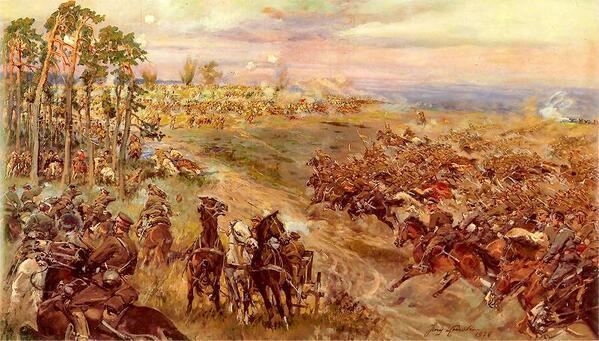Date 31 August 1920 | Result Decisive Polish victory | |
1,700 men, 6 regiments 17,500 men, 20 regiments Combatants Poland, Second Polish Republic, Russian Soviet Federativ, Soviet Russia Similar Polish–Soviet War, Battle of Warsaw, Battle of Zadwórze, Kiev Offensive, Battle of Radzymin | ||
Bitwa pod komarowem 1920 battle of komar w
The Battle of Komarów, or the Zamość Ring, was one of the most important battles of the Polish-Bolshevik War. It took place between 30 August and 2 September 1920, near the village of Komarowo (now Komarów) near Zamość. It was one of the largest cavalry battles since 1813 and the last great battle of any significance in which cavalry was used as such and not as mounted infantry.
Contents
- Bitwa pod komarowem 1920 battle of komar w
- Zwaistun battle of komar w
- Eve of the battle
- Initial clashes
- Phase One
- Phase Two
- Results and casualties
- References

The battle ended in complete disaster for the Russian 1st Cavalry Army, which sustained heavy casualties and barely avoided being surrounded and annihilated. After the battle, the morale of the 1st Cavalry Army collapsed, and this once most feared Soviet army no longer remained an effective fighting force.

Zwaistun battle of komar w
Eve of the battle

After the Battle of Zadwórze, the forces of the Bolshevik 1st Cavalry Army under Semyon Budyonny were halted for over a day. By this time the Russian cavalry units had lost much of their initiative and had not managed to reach or intervene in the Battle of Warsaw. After the Bolsheviks lost the struggle for the capital of Poland and started their retreat eastwards, the forces of Budyonny were ordered by Tukhachevski to march northwards to attack the right flank of Józef Piłsudski's advancing forces in order to draw Polish forces away from the north and relieve pressure on the routed Bolshevik Western Army. Tukhachevski believed that if Polish forces were required to turn south, he could reverse the disaster unfolding in the north and resume his westward offensive to capture Warsaw.
However, heavy fighting in the area of Lwów and the upper Bug River postponed the march. By the time the 1st Cavalry Army reached the area of Zamość on August 30, 1920, the Poles had already managed to redirect much of their troops to the area and organize a line of defense.
Initial clashes
On August 29, the 1st Cavalry Army fought the first battle with units of Polish 1st Cavalry Division. A small "Special Battalion" led by Major (later General) Stanisław Maczek fought a successful delaying action near the village of Waręż. Later that day, the Polish 1st Krechowce Uhlan Regiment chanced upon several unprepared Bolshevik units and took 150 POWs, three pieces of artillery and seven machine guns in the villages of Łykoszyn and Tyszowce.
The following day, the Bolshevik units continued their advance towards Zamość, but found the Polish mobile defence difficult to break. The garrison of the fortress was composed of a number of units commanded by Captain (later General) Mikołaj Bołtuć. Among them were the remnants of Ukrainian 6th Infantry Division under Colonel Marko Bezruchko, one regiment and two battalions of Polish infantry, three armoured trains and a number of smaller units, some 700 bayonets and 150 sabres altogether. At the same time, the Polish 1st Cavalry Division moved to the villages of Wolica Brzozowa and Komarów, to the west of the city.
On his arrival in the Zamość area, Budyonny was left with three choices: he could assault the heavily defended city, try to break through the trenches of the 13th Infantry Division (Poland) in the forests west of it, or try to attack the unknown number of Polish cavalry units some 20 kilometres (12 mi) to the west. Despite having little knowledge of the opposing forces, Budyonny did not expect significant opposition just yet and ordered his troops to bypass the city from the west.
Phase One
In the early morning of August 31, a Bolshevik cavalry brigade crossed the belt of swamps to the north of the Polish positions. At the same time, the 11th Cavalry Division was engaged by Polish infantry in the village of Łubianki, while the 6th Cavalry Division was cut out overnight by Polish infantry to the west of Zamość.
At 6 o'clock in the morning, the 200 man 2nd Regiment of Grochow Uhlans was ordered to capture "Hill 255" to the north of the main lines of Polish cavalry. The hill was captured with no opposition. Soon afterwards, a large Russian tabor was spotted, disorganised and mixed with a much larger unit of Bolshevik cavalry. With no time to hesitate, the Poles charged, inflicting heavy casualties on the enemy rear units. Soon afterwards, the Poles were successfully counter-attacked by Russian troops and forced to abandon the hill and retreat into the nearby village of Wolica Śniatycka. There the Russian advance was stopped by Polish heavy machine gun fire and at 10 o'clock the Polish 9th Regiment of Lesser Poland Uhlans under Major (later General) Stefan Dembiński charged the Russian positions and managed to recapture Hill 225. The Russians counterattacked several times, but to no effect.
Meanwhile, the village of Wolica Śniatyńska, lost to the Bolshevik cavalry, was charged by the Polish 8th Uhlan Regiment of Duke Jozef Poniatowski. After a short fight, the disorganised Bolshevik forces were forced to retreat, leaving behind a large part of their heavy equipment and Budyonny's staff car. The Russian commander himself evaded being captured. The Bolshevik 4th Cavalry Division was routed.
At 12 o'clock, the Polish 9th regiment started another charge down the hill on the Russian 11th Cavalry Division that had replaced the withdrawing 4th Division. The assault was repelled, with heavy casualties on both sides. After approximately 30 minutes, the Russian forces were forced to retreat; however, the Polish VII Cavalry Brigade was seriously depleted. Also, the 9th Regiment suffered serious casualties from friendly artillery fire.
The Polish VI Cavalry Brigade, until then kept as a reserve, started a pursuit down the hill. After a cavalry charge on the left flank of the withdrawing Bolshevik cavalry, the latter started a disorganised retreat towards Zamość. The pursuit was carried over by the 12th Podolian Uhlan Regiment under Captain (later General) Tadeusz Komorowski. During the retreat, the Poles inflicted heavy casualties on the enemy. After the pursuit ended, the fighting was halted until 5 p.m.
Phase Two
At approximately 5 p.m., the 8th Regiment near the village of Wolica Śniatycka was yet again assaulted by Bolshevik cavalry. To counter the threat, Colonel Rómmel ordered the whole VI Cavalry Brigade (1st, 12th and 14th Regiment of Jazlowiec Uhlans) to charge the enemy's flank. After a huge clash, the Russian forces in the area fell back northwards.
After a short rest, the whole Russian 6th Cavalry Division, the strongest unit in the area, managed to finally break through a Polish infantry encirclement and arrived at the battlefield. The Polish VI Brigade was resting in and around the village of Niewirków, where it had withdrawn after the successful pursuit several hours earlier. The VII brigade started its march north-east to join the forces of VI Brigade near Niewirków. Halfway, it spotted a huge Russian line emerging from the forests around Wolica Śniatycka.
The Russian 6th Division (six regiments strong) formed a line, but had not yet initiated an assault. Juliusz Rómmel ordered all his available units to launch an all-out assault before the Russians started their attack. The 8th and 9th Regiments made a frontal charge, while the 1st Krechowce Uhlans Regiment was ordered to attack the left flank of the enemy. Soon it was joined by the remaining elements of the 12th Regiment from Niewirków, charging the enemy positions from the rear. After a 30-minute clash, Budionny ordered his division to retreat.
The only available way led east, through the positions of the dug-in 2nd Legions Infantry Division under Colonel Michał Łyżwiński. The retreating Bolsheviks managed to break through, but suffered heavy casualties. By the end of the day, the battle was over.
Results and casualties
The Polish 1st Cavalry Division then pursued the retreating Soviets. The forces of Budyonny managed to break through Polish lines, but the Poles did not leave them enough time to rest and reorganise. On September 2, the Polish VI Cavalry Brigade reached Łaszczów, where it successfully outflanked the Russian 44th Infantry Division and annihilated one of its regiments (only 100 POWs survived the battle). The 1st Cavalry Army itself was not surrounded and managed to avoid complete destruction, but it no longer posed a threat to the advancing Poles. Unable to regroup, on September 5, 1920 it lost the town of Hrubieszów, and Włodzimierz Wołyński the following day.
On September 12, 1920, Polish forces withdrawn from the Battle of the Niemen under General Władysław Sikorski started a successful offensive on Bolshevik-held Volhynia. Pressed from all directions, the 1st Cavalry Army lost Równe on September 18 and was forced to retreat further eastwards. By the end of September, the Polish forces reached the Słucza River, near the lines held by the Reds before their offensive towards Warsaw started. Soon afterwards, Budyonny's Army had to be withdrawn from the front, not to return until after the cease fire that October.
The Battle of Komarów was a complete disaster for the Russian 1st Cavalry Army. Numerically greatly superior, it failed to concentrate and act as an organised unit, which resulted in several consecutive waves of attacks, each of them repelled by the Poles. A lack of communication and complete disregard for intelligence reports resulted in heavy losses on the Russian side. After the battle, its political commissars, Joseph Stalin and Kliment Voroshilov, failed to control the men in their command: with morale and discipline at a low point, robbery and violence by the 'Red Cossacks' against the civilian population became commonplace. The 1st Cavalry Army also became known for periodic outbreaks of murderous anti-semitism.
The Polish Army lost approximately 500 killed in action and 700 horses. No Poles were taken prisoner by the Red Army. The exact losses of the latter are unknown and were never made public.
Because of the numbers of forces involved, the Battle of Komarów is considered the greatest cavalry battle of the 20th century. It is sometimes referred to as "the greatest cavalry battle after 1813" or the "Miracle at Zamość" (the latter particularly in Ukrainian literature), however, the former is incorrect. More cavalry were present at the 1863 Battle of Brandy Station, during the American Civil War, than at Komarów.
